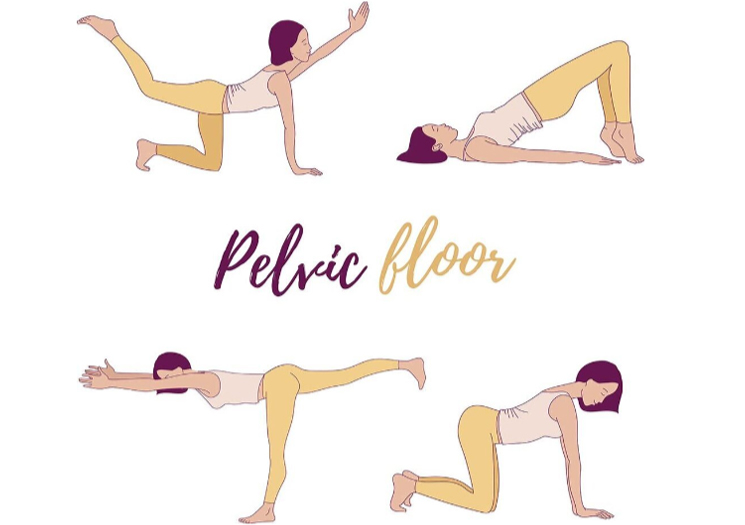- Find a Provider
-
Services
-
Redeemer Health provides compassionate care across every stage of life.
- View all Services
- Health Care
- Cancer Care
- Heart Care
- Hospital at Home
- Maternity Care
- Pediatric Urgent Care
- More Health Care Services
-
- Patients & Visitors
- Locations
- Careers
categories:

It’s a sensitive subject. But it needn’t be. We’re here to talk about it all. Because it’s time pelvic floor wasn’t taboo. We’re here to share the all natural nitty gritty, about your pelvic floor. And more. Maybe you haven’t really thought why your pelvic floor matters. As a web of muscles, ligaments and tissues that stretches across your pelvic bones, it does the important job of supporting all your pelvic organs. These organs include your vagina, womb, bladder and bowels.
During pregnancy our core, which includes your pelvic floor, back, abdomen, and hips, undergoes a lot to nurture your little bundle of joy. Over nine months and during birth, the muscles in your pelvic floor become stretched. The weight of your baby, hormones that loosen your tissues, and the efforts of labor all put extra pressure on this part of your body. As a result your pelvic floor may become weakened or damaged. This isn’t unusual. In fact, many moms experience changes after pregnancy.
Don’t suffer in silence
This means you may experience leakage or gas when you exert insignificant levels of energy. For instance some women experience leakage when lifting their baby, grabbing groceries, coughing and sneezing-- or even laughing! Some women also suffer from back, hip, and pelvic floor pain. But this condition isn’t irreversible. You don't have to suffer in silence. And no, you don’t have to laugh it off. Because many moms are finding yoga is a successful way to improve postpartum pain, leakage, and postural changes.
These common yoga moves may be helpful to try at home in the postpartum period:

Let’s customize a personal core program
However, not all exercises are optimal for everyone. So you may want to consider consulting a female therapist who specializes in pelvic floor and women’s health. Sharing details with an expert may feel intimidating, but as with your obstetrician, you’ll quickly develop a comfort level and rapport. By assessing your personal needs and developing a personal program of exercises and manual therapy, you can partner on improving your symptoms together.
Redeemer Health offers this type of discrete specialized care. If you think you would benefit from pelvic floor/ women's health physical therapy, please call 215-938-5621
Has pelvic floor therapy or yoga helped you? We’d love to hear your experience in the comments below.
categories:

On February 1st, the Thursday before the Super Bowl, the Holy Redeemer Maternity Unit, was popping with Philadelphia Eagles pride. Babies donned their custom hats. Nurses flaunted their favorite Eagles gear. And pennants reminded visitors of last year’s champs. All in celebration of the Eagles’ tinniest fans.
Busy hands. Happy hearts
Thanks to the creative energies of Marie Milcarsky and Dorothy “Dot” McHale no head was ignored. Because every baby in the NICU and Maternity Unit received a special handmade Eagles hat to wear for the big game.
Marie, a housekeeper with Holy Redeemer Hospital, has crocheted miles of yarn in her time. Making baby hats for the past seven years, she’s hooked creations for every occasion. Even an impressive white crown for the first baby born in 2018. Meanwhile fellow maker Dot, an 80-year-old retired resident of Maple Shade, NJ, thought it would be fun to make red baby hats to honor February’s heart month theme. But she didn’t stop there. After watching tutorials on YouTube, she got the idea to make the babies green football hats in honor of the Super Bowl.
Yarn: the healer
Dot, accompanied by her daughter, Maureen, a Redeemer Health employee, attended our Tiniest Fans Pep Rally and hand delivered her precious hats to the tiniest fans. Clearly Dot and Marie know they like to crochet. But what they may not know is that several health authorities agree about handicraft. It’s believed that using knitting or crochet as meditation can be a daily way to minimize the effects of stress in your life. Which ultimately can help reduce heart disease.
Hooking or knitting is also a great way to build a community and reduce depression and isolation. So maybe it’s time for us all to consult YouTube and start making.
Game on
The Tiniest Fans Pep Rally gathered over 40 Eagles fans ready to cheer on the Birds in the big game. Staff, employees, proud parents and picturesque hat- wearing babies all showed up. The tiny pep rally also drew attention from local news outlets including Fox29, 6ABC, NBC10, CBS3, and the Bucks County Courier Times.
categories:

When you’re pregnant many doctors provide a long list of foods and beverages that are off limits. We know this can feel restrictive. But, thankfully there’s a much longer list of appetizing things you can enjoy. These foods help support a healthy pregnancy, keep you feeling well, and help your baby thrive.
With the extra demands on a woman's body and the increase in blood volume, anemia is a very common condition in pregnancy. In fact, about one of every two pregnant women doesn’t get enough iron. Low levels can increase your risk for preterm birth of low birth weight. You may feel tired, weak, or dizzy, or experience headaches if your iron levels are too low.
Pumping iron
Iron is found in many foods including dark, leafy greens, such as broccoli, brussel sprouts, spinach, collard greens and kale. It’s also found in dried fruits, fortified cereals and grains. Meat (particularly red), fish and tofu are a great source of iron. As are lentils, peas and beans. Integrating extra iron into your diet can be as simple as adding dried apricots or figs to your store-bought cereal or trail mix. Consider replacing that iceberg side salad with some dark leafy greens like baby kale or arugula. Or try roasted brussel sprouts as a healthy side. Thinking about adding extra iron to every meal can take a little practice. But, once you get creative, you’ll reach your daily recommended dose of 27 milligrams of iron in no time.
Try this family friendly broccoli frittata
Cooking when you’re tired can be exhausting. We get it that mommy-to-be needs all the help she can get. So here’s a super healthy meal the whole family will like. With 15% of your daily recommended iron intake it’s a smart, and easy choice...
1/2 cup nonfat cottage cheese
2 cups fat-free egg substitute
1 large onion, diced
1 tsp. olive oil
2 cups frozen chopped broccoli
1/2 tsp. dried dill
2 tsp. margarine
Mix cottage cheese and egg substitute together, set aside. In large nonstick frying pan over medium heat, saute onion in oil for five minutes, or until soft. Add broccoli and dill; saute for five minutes, or until the mixture softens. Set aside.
Wipe out frying pan. Add 1 tsp. margarine and swirl the pan to distribute.
Add half of the vegetable mixture, and then half of the egg mixture; lift and rotate pan so that eggs are evenly distributed. As eggs set around the edges, lift them to allow uncooked portions to flow underneath. Turn heat to low, cover the pan, and cook until top is set. Invert onto a serving plate and cut into wedges. Repeat with remaining 1 tsp. margarine, vegetable mixture, and egg mixture. And that’s it!
Serves 4: Each serving provides: Calories 150, Total fat 3 g, Saturated fat 0 g, Cholesterol 0 mg, Sodium 390 mg, Total carbohydrate 12 g, Fiber 3 g, Sugar 3 g, Protein 19 g.
Got an iron-rich recipe you really like? Share it with all of our moms in the comments section below!
categories:

Welcome to the third trimester! As the time approaches to meeting your little one, you may be wondering what you should be doing during the last part of your pregnancy. Here is a list of ten things for your to-do list in the third trimester:
1. Get Familiar with Third Trimester Screenings and Visits
The frequency of your routine check-ups will increase during the last trimester to every two weeks, and eventually every week. Your doctor will want to perform certain tests, such as Group B Strep, and administer any immunizations you may want. If your blood type is Rh Negative, you will most likely receive a Rhogam injection, if you haven’t had one already during your pregnancy. Ask your doctor for a list of tests and additional exams you can expect in your third trimester.
2. Finish Taking Prenatal Classes
Take a look at all of the classes offered in your area, and decide which ones would benefit you. Remember to sign up as early as possible, as these classes can fill up quickly. Consider classes such as childbirth, breastfeeding, or infant CPR. Here’s a link to classes offered by Redeemer Health.
3. Start Doing Kick Counts
Around week 28, start keeping track of your baby’s movements. The general rule of thumb is ten fetal movements in two hours. If you notice any decrease in movement, it’s a good idea to notify your doctor.
4. Choose a Pediatrician
Before you go into labor, you should choose a pediatrician for your baby. Doctor’s offices will typically hold meet and greet sessions, where you can familiarize yourself with the staff and the office policies.
5. Read and Ask Questions about Breastfeeding
If you have decided to breastfeed your baby, now is the time to learn about what to expect and any complications that may arise. It’s often a good idea to take a breastfeeding class if this is your first baby. The key to breastfeeding successfully and in a way that’s healthy for you and baby is having the support YOU need. The Breastfeeding Resource Center is here to help.
6. Take a Hospital Tour
Before going into labor, try to take a tour of the hospital or birthing center where you intend to give birth. This gives you the opportunity to get familiar with the layout of the facility.
7. Install the Car Seat
All babies are required to ride home from the hospital in a car seat, and now is a good time to have it installed. Often, you can take the car seat to a local fire or police department certified in car seat installation, and have them install it for you to make sure it is done correctly.
8. Read and/or Take a Class on How to Take Care of Baby
Now that you’ve probably read all about your pregnancy, it’s time to start reading about how to care for your baby once they arrive. Redeemer Health offers a few options for classes.
9. Know the Signs of Labor
There are several signs your body is preparing for labor, including regular tightening in the pelvic area and the onset of a backache. Knowing the signs that you might be in labor is important so you know when to call your doctor and when to head to the hospital. Experiencing any of these signs before 37 weeks could indicate preterm labor, and should be reported to your doctor right away.
10. Plan or Plans in Place For When You Go Into Labor
As soon as your contractions begin, you will want to have a plan in place so you know who you should call and where you need to go. Have your hospital bag ready so you will have one less thing to worry about before heading out to meet your baby.
While it seems like there’s a lot to do before baby comes, the third trimester is also a good time to slow down, relax and enjoy the final stage of your pregnancy. The best is yet to come!
categories:
Hearing that a loved one will benefit from hospice care may result in a flood of emotions.
Perhaps the news that a loved one has a limited life expectancy was unforeseen and a departure from the hope for a cure that once occupied your thoughts. Perhaps the suggestion of hospice care comes as a relief and provides hope that help will soon be available to provide much needed comfort, support, and care coordination.
Whatever the circumstance that leads to a recommendation for hospice there may be many questions that follow. What is hospice care? How can they help me and my loved one? And how do I choose a hospice? You may find that there are just a few hospice programs in your region, or you may find as many as 80 or more hospices to choose from.
The following questions may guide you in knowing what to ask and help you in making an informed decision when choosing a hospice provider:
Is the hospice program certified and licensed by the state or federal government?
Most hospices are certified by Medicare and licensed by the state where they provide care. This ensures that certain rules are followed, required services are provided, and that Medicare or Medicaid will pay for services.
What other kinds of accreditation or certification does the hospice program or its staff have?
While not required, many hospices seek accreditation from national organizations that ensure the hospice meets quality standards. Also, hospice team members may have certification in hospice and palliative care or in their profession.
Can I get references, or find out about any accreditation a hospice has?
Yes. The National Hospice and Palliative Care Organization maintains a directory of all organizational members, providing information about certification and accreditation status as well as other important program information.
How long has the hospice been servicing your community? Who owns or governs the hospice?
How long a hospice has serviced your community, and whether a hospice is not-for-profit, for-profit, faith-based, free-standing, or part of a health system may be important to you.
What screening and training do staff and volunteers receive?
Ask about the number of hours and content of initial training as well as the hospice program requirements for ongoing education of staff and volunteers.
What additional services or programs does the hospice offer?
Federal regulations require all hospices to provide nursing, social work, pastoral care, hospice aide, volunteer, and certain bereavement services. Some hospices have additional services that may include complementary therapies, community bereavement programs and support groups, palliative care, veterans’ programs, pediatric care, or specialized volunteer programs, to name a few.
How does the hospice respond to calls and concerns in the evening, night, and weekend hours?
Ensuring that help is available to you at any time of the day or night to address your concerns and visit your home, when necessary, is critical. Find out how the hospice will respond to these needs.
What will happen if the care can’t be managed at home?
While the needs of nearly all people can be managed in the home, knowing what other options are available for assistance in the event of medical crisis will bring you much needed peace of mind. Some hospices have freestanding inpatient hospice units or houses, while others contract with local hospitals or nursing homes.
What measures does the hospice use to ensure quality?
Public quality reporting for hospice programs will begin within the next year. Many hospices are already collecting data regarding certain quality measures. Inquire about what measures the hospice collects, including how quickly pain and other symptoms are controlled and what actions the hospice has taken to improve in these areas.
Does the hospice measure family satisfaction with care?
Through a brief survey, many hospices ask family members for feedback about care in order to ensure excellence and improve where necessary. Ask the hospice if they measure family satisfaction and how their results compare to other programs.
It is increasingly common for healthcare consumers to explore options and even interview providers prior to making care decisions. Hospice is no exception. Whether choosing between three hospices or 80, understanding what makes hospice programs similar and understanding how they may be different is essential to choosing a hospice that will meet the unique needs of you and your loved one.
To learn more about hospice services at Holy Redeemer, visit Hospice Care.
